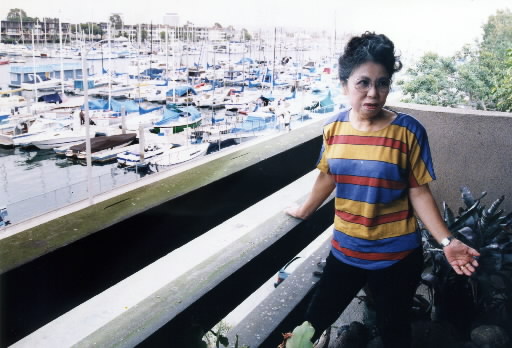Hiroshima Girls, Part 3: Half a Century After the Bombing [2]
Jul. 3, 2010
"Two Normans" bring joy to woman's world
by Masami Nishimoto, Staff Writer
This feature series on the "Hiroshima Girls," also known as "Hiroshima Maidens," is a close look at a number of Japanese women who were impacted by the atomic bombing of Hiroshima. The series was originally published in 1996.
Marina del Ray in the suburbs of Los Angeles commands a view of the Pacific Ocean. Outside the room of her house, a yacht harbor, one of the great marinas on the West Coast, stretches into the distance. Shigeko Sasamori, 64, stood comfortably in bare feet on the veranda and said, "The view from this room is really nice, isn't it? Norman likes it, too."
A photo of "two Normans" is placed in the living room, through which a breeze blows gently in the sunlight. They are the late Norman Cousins, who led the project of providing medical treatment for the "Hiroshima Girls" and passed away in 1990 at the age of 75, and Norman Sasamori, 33, Ms. Sasamori's son. Norman Sasamori established a law firm three years ago and now lives with his mother.
"I named my son after Mr. Cousins, my moral parent," she explained. "I've been encouraged and supported by those who empathize with other people's feelings and then act. I've learned a lot of things from their attitudes, too. These things are nourishment for my life."
Dressed in a colorful T-shirt, the petite survivor looked young. Ms. Sasamori has come far since "that day." This year marks the 40th year of her life in the United States, where she has obtained citizenship.
She experienced the atomic bombing as a first-year student with bobbed hair at Hiroshima Girls' School of Commerce. Because her hand was burned so severely she was unable to even grasp a pencil, she gave up going back to school. Instead, Hiroshima Nagarekawa Church, where the Rev. Kiyoshi Tanimoto served, became her "school." Rev. Tanimoto, who died in 1986 at the age of 77, would propose the treatment of A-bomb survivors (hibakusha) in the United States.
At Nagarekawa Church, Ms. Sasamori attended a Bible class at which A-bomb women of her generation gathered. She was later baptized and she set her heart on becoming a nurse.
When she was 21, Norman Cousins came to Nagarekawa Church during his second trip to Hiroshima. Her encounter with Mr. Cousins at the church that fall led to her calling him "Father" for the rest of her life. "It seems he was concerned about me from the time we first met, as I was so immature at the time," Ms. Sasamori said with a smile.
In 1957, the year following her return to Japan after receiving medical treatment in the United States, she went to New York again with the support of Mr. Cousins and attended a nursing school and an evening high school. Her little finger and ring finger on her right hand still remain crooked. Even while working as a nurse, she was always faced with difficulties and hardships.
"I may have cried each time, but I have a positive outlook." Her mind-set of looking ahead and soldiering on, even when she became a single mother, led her to choose to live in the United States.
In 1980, she moved to Los Angeles. While working as an assistant nurse, handling newborn babies, she began to get deeply involved in activities to convey her account of the atomic bombing. She was guided in this by Mr. Cousins, who overcame illness to become an adjunct professor at the School of Medicine at the University of California, Los Angeles.
She offered her A-bomb account, the first A-bomb account introduced to the U.S. Congress, at a Senate hearing in 1980, at an antinuclear classical music concert held in Boston in 1982, and at the "Survival Day Meeting" in Los Angeles in 1984, for which about 20,000 people gathered. She felt it was her duty to appeal to the public, in part thinking of the lives of the newborn babies she saw day and night.
Encounters with a variety of people produce new connections and open new worlds. At the request of the main star of the movie "Batman Forever," she served as a babysitter for his children. Until the day prior to our interview, she was in Hawaii visiting those suffering from leprosy.
"Hibakusha are not the only ones who have experienced hardship," said Ms. Sasamori. "I think there are more situations in the world that should be made known and conveyed."
"Many people died at Pearl Harbor. When a war breaks out, everyone becomes a victim. It isn't acceptable to simply point to Hiroshima."
Frank thoughts flowed as smiles punctuated her words. Then, surprised by the time, she moved to quickly dress for a meal with a friend from Japan.
(Originally published on July 27, 1996)








